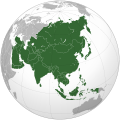
Amasia is a possible future supercontinent which could be formed by the merger of Asia and the Americas. The prediction relies mostly on the fact that the Pacific plate is already subducting under Eurasia and the Americas, a process which if continued will eventually cause the Pacific to close. [1] Meanwhile, because of the Atlantic mid-ocean ridge, North America would be pushed westward. Thus, the Atlantic at some point in the future would be larger than the Pacific Ocean. In Siberia, the boundary between the Eurasian and North/South American plates has been stationary for millions of years. The combination of these factors would cause the Americas to be combined with Asia, thus forming a supercontinent.
Contents
A February 2012 study predicts Amasia will form over the North Pole, in about 50 to 200 million years, closing the Arctic Ocean, [2] while a 2022 model suggests that it might take as much as 600 million years for Amasia to form as the Pacific closes, and that much of the detail of how and how fast the continents move would depend on the strength of the oceanic lithosphere. [3]










